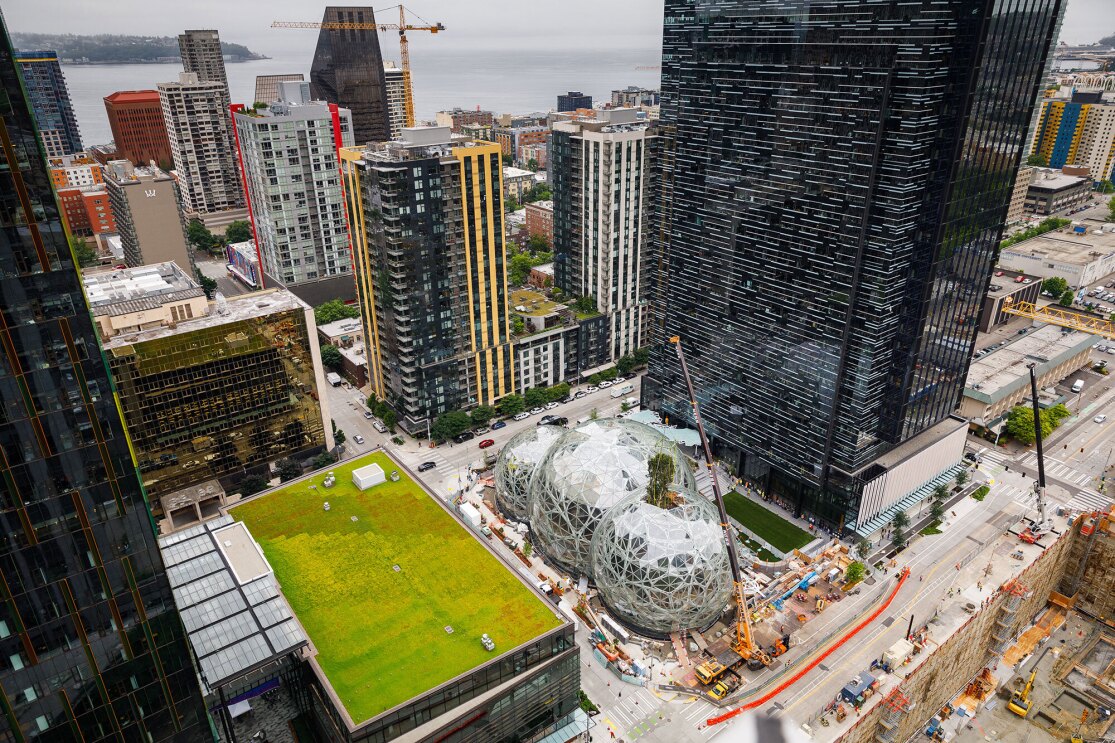As winter approaches, an innovative heat source will be keeping Amazon's corporate headquarters in Seattle warm. Instead of employing a typical boiler system, the offices in The Regrade rely primarily on an underground "eco-district" that carries recycled energy.
The idea of district energy—subterranean networks of pipes that ferry water or steam between buildings for heating and cooling—isn't new. Cities around the globe such as Boston, Copenhagen, Tokyo and Paris rely on such systems, some of which date back more than 100 years and often linked up to conventional power plants.
What sets Amazon’s district energy system apart
The twist with Amazon's system is that it uses waste heat from a non-Amazon data center, the neighboring Westin Building Exchange. A "carrier hotel" that houses more than 250 telecom and Internet companies, the 34-story Westin had heat to spare. Amazon arranged to capture that energy for its campus across the street.
Instead of venting its heat into the atmosphere from rooftop cooling towers, the Westin pipes it to a central plant in Amazon's Doppler tower. At about 65°F, the arriving water isn't quite hot enough to warm offices, so it's run through five heat-reclaiming chillers that concentrate the heat into a smaller volume of water, raising the temperature to about 130°F. A 400,000-gallon tank provides low-grade heat storage and an emergency water supply for Westin if needed.
01 / 06
The campus buildings have backup boiler systems to deliver supplementary heat on the coldest days. But over two winters so far, "we're finding that we rarely need to use the boilers," says Mike Moriarty, the Senior Engineering Manager who leads operations and maintenance for The Regrade campus. “That surprised people."
The system will ultimately heat about 5 million square feet of office space when construction of the new complex is complete. Recycling excess energy from the Westin will save some 80 million kilowatt hours of electricity use over 25 years—an amount equivalent to the carbon dioxide emissions of 65 million pounds of coal.
Projects like this one that cut energy use and boost efficiency are helping the city of Seattle pursue a goal to become carbon neutral by 2050. "The stars aligned" for the ecodistrict, Moriarty says, because the city was interested in hatching energy-saving projects around the same time Amazon set out to reimagine four underdeveloped blocks near the Westin Building.
I'm familiar with other properties that have used waste heat from a data center, but not across owners. That's what made this one a little unique.
Mike Moriarty
No employee or visitor to one of the offices in The Regrade would sense that there's anything special about the climate control. Underground pipes bring the energy to Doppler, while hidden radiant coils circulate the heat, keeping offices comfortable. A control system at the central plant helps engineers optimize the energy flow. All of it is invisible to the occupants.
Because of the up-front investment to build it, the ecodistrict isn't currently delivering heat that's any cheaper compared to a typical system, according to Moriarty, but "the price of electricity is only going to go up."
The commitment to district energy in Seattle is just one part of a broader effort at Amazon to operate sustainably, from boosting renewable energy resources to improving packaging. Doppler and the adjacent Meeting Center have green roofs that filter rainwater and reduce cooling loads, while six of Amazon's Seattle buildings have LEED Gold certification for sustainable design and construction.
 Photo by (JORDAN STEAD / Amazon)
Photo by (JORDAN STEAD / Amazon)The campus also benefits from having a system that can scale across multiple buildings, rather than one requiring individual units to be installed and maintained. Moriarty says the ecodistrict has been so effective that the scope has been expanded to more planned square footage, and a sixth chiller may be added as demand increases.
The Doppler building is expected to earn a federal ENERGY STAR rating of 98 out of 100 for its first year of operation—an admirable feat for any office building, but particularly one with thousands of employees and a lot of activity to power.
"These buildings are vibrant," Moriarty points out. "There's a lot going on."
Amazon's district energy system required collaboration across city agencies, development firms, architects, and engineers—not to mention Westin and Amazon itself. There were skeptics who didn't think the idea would work, Moriarty acknowledges.
"We've proven that you can do it," he says. "And as time goes on, we'll do it more efficiently."
Trending news and stories







